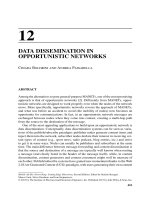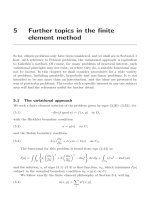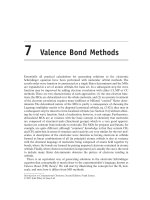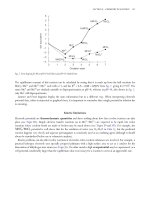Ebook Fundamentals of renal pathology (2nd edition) Part 2
Bạn đang xem bản rút gọn của tài liệu. Xem và tải ngay bản đầy đủ của tài liệu tại đây (11.81 MB, 99 trang )
Part V
Vascular Diseases
Nephrosclerosis and Hypertension
10
Arterionephrosclerosis
Introduction/Clinical Setting
Approximately 60 million people in the United States have hypertension. Many are
undiagnosed or untreated. Different populations have different risks and different
consequences of hypertension. Increased hypertension is seen with aging, positive
family history, African-American race, and exogenous factors such as smoking.
Although African-Americans make up only 12 % of the US population, they are
fivefold overrepresented among patients with end-stage renal disease (ESRD) presumed due to hypertension [1, 2]. Hypertension is associated with significant morbidity and mortality due both to cardiovascular and renal diseases [1–5].
Essential hypertension is diagnosed when no cause is found. Hypertension may
also be secondary to various hormonal abnormalities, including excess aldosterone,
norepinephrine, or epinephrine, or produced from adrenal cortical, medullary, or
other tumors; renin-producing tumors; or hypercalcemia or hyperparathyroidism.
Other secondary causes include neurogenic, iatrogenic, and structural lesions (e.g.,
coarctation of the aorta).
Renal hypertension refers to hypertension secondary to renal disease. Chronic
renal disease is the most common form of secondary hypertension (5–6 % of all
hypertension). The kidneys modulate blood pressure in several ways: They modulate salt/water balance under the influence of aldosterone. The kidney is also a
major site of renin production, which allows generation of angiotensin II, an important vasoconstrictor and stimulus for aldosterone secretion. In renovascular disease
(i.e., stenosis of the renal artery), renal ischemia is thought to be the stimulus that
increases renin-angiotensin system activity, thereby increasing systemic blood pressure. In renal parenchymal disease, multiple factors contribute to increased blood
pressure. The decreased mass of functioning nephrons leads to a decrease in the
glomerular filtration rate (GFR), leading to increased extracellular volume and
increased angiotensin, aldosterone, and other vasoactive substances.
A.B. Fogo et al., Fundamentals of Renal Pathology,
DOI 10.1007/978-3-642-39080-7_10, © Springer-Verlag Berlin Heidelberg 2014
125
126
10
Nephrosclerosis and Hypertension
The most common complications in untreated hypertension are cardiac, renal,
and retinal disease. Half of hypertensive patients die of cardiac disease, 10–15 % of
cerebrovascular disease, and about 10 % of kidney failure. Treatment to decrease
blood pressure reduces mortality and especially reduces the incidence of cerebrovascular accidents. Hypertension accelerates the decline in GFR characteristic of
many chronic kidney diseases, whether the primary cause is hypertension associated or not. Chronic kidney disease is common, affecting 195,000 Americans, with
45,000 new patients enrolled in end-stage treatment Medicare programs yearly. It
has been postulated that direct transmission of increased blood pressure to the
glomerulus increases injury. Other mechanisms may also play a role, however, since
antihypertensive drugs have benefit even in nonhypertensive patients with chronic
kidney disease (see below). Recent studies point to strong genetic factors linked to
risk of hypertension-associated kidney injury, although mechanisms are not yet
elucidated.
Pathologic Findings
Gross Findings/Light Microscopy
“Benign” nephrosclerosis results in small kidneys with finely granular surface and
thinned cortex in late stages. Malignant (accelerated) nephrosclerosis grossly
shows petechial hemorrhage of the subcapsular surface, with mottling and occasional areas of infarct. Microscopically, in “benign” arterionephrosclerosis there is
vascular wall medial thickening with frequent afferent arteriolar hyaline deposits
and varying degree of intimal fibrosis. The hyalinization is due to endothelial
injury and increased pressure, leading to an insudate of plasma macromolecules.
There are associated focal glomerular ischemic changes with variable thickening
and wrinkling of the basement membrane and/or global sclerosis, tubular atrophy,
and interstitial fibrosis (Fig. 10.1). Global sclerosis more commonly is of the
obsolescent type, with fibrous material obliterating Bowman’s space. Solidified
glomeruli, where the tuft is globally sclerosed without collagen in Bowman’s
space, has been called “decompensated” arterionephrosclerosis. Secondary focal
segmental glomerulosclerosis (FSGS) may also occur, often with associated glomerular basement membrane (GBM) corrugation and filling of Bowman’s space
with fibrous material [4–10]. These morphologic features hint that the segmental
sclerotic process is secondary to hypertension-associated injury, rather than idiopathic FSGS. The lesions associated with accelerated hypertension consist of
mucoid change of the arterioles, often with red blood cell (RBC) fragments within
the wall. In malignant hypertension, arterioles show fibrinoid necrosis, and interlobular arteries have a concentric onion-skin pattern of intimal proliferation and
fibrosis, overlapping with the appearance of scleroderma and chronic thrombotic
microangiopathy (Fig. 10.2) (see below). There is proportional tubulointerstitial
fibrosis in arterionephrosclerosis.
Arterionephrosclerosis
127
Fig. 10.1 Arterial and
arteriolar medial thickening,
intimal and interstitial
fibrosis, tubular atrophy, and
global sclerosis in
arterionephrosclerosis (PAS)
Fig. 10.2 Vascular fibrinoid necrosis and thrombosis in malignant hypertension (Jones silver
stain)
Immunofluorescence may show trapping of IgM and C3 in glomeruli, but there
are no immune complex-type deposits. In malignant hypertension, fibrin/fibrinogen
staining may be present in necrosed arterioles/arteries and injured glomeruli.
128
10
Nephrosclerosis and Hypertension
Electron microscopy confirms the corrugated, wrinkled GBM and ischemic
changes with increased lamina rara interna but without immune deposits. Hyaline
may be present in sclerosed segments. Some foot process effacement of podocytes
may also be present, but it is usually not extensive.
Although none of the above lesions are pathognomonic, the constellation of
these changes in the absence of other lesions of primary glomerular disease is indicative of arterionephrosclerosis.
Etiology/Pathogenesis
Hypertension has been presumed to cause end-organ damage in the kidney, and
hypertension undoubtedly accelerates progressive scarring of renal parenchyma,
but the relationship of hypertension and arterionephrosclerosis is not simple and
linear [11]. In a large series of renal biopsies in patients with essential hypertension, arterionephrosclerosis was present in the vast majority, and the severity of
arteriolar sclerosis correlated significantly with level of diastolic blood pressure
[9]. However, in several large autopsy series of patients with presumed benign
hypertension, significant renal lesions were rare [4, 5]. Further, the level of blood
pressure does not directly predict degree of end-organ damage: African-Americans
have higher risk for more severe end-organ damage at any level of blood pressure
[2]. The African American Study of Kidney Disease (AASK) trial showed that
African-Americans with presumed arterionephrosclerosis indeed did not have
other lesions, by renal biopsy, but the global sclerosis was severe and did not correlate with vascular sclerosis [12]. It is possible that underlying microvascular
disease causes the hypertension and the renal disease in susceptible patients. In a
large study of patients without clinically evident kidney disease at baseline, even
relatively modest elevation in blood pressure was an independent risk factor for
development of end-stage kidney disease [13]. Underlying causes in addition to
direct hemodynamic injury could include possible genetic and structural components, such as decreased nephron number and consequently fewer, but enlarged
glomeruli [14]. Whether hypertension can cause kidney scarring, or a primary
microvascular renal injury causes the hypertension, which in turn accelerates the
sclerosis, has not been proven. Apolipoprotein L1 allele variants are tightly linked
to excess arterionephrosclerosis, focal segmental glomerulosclerosis, and HIVassociated nephropathy, but not diabetic nephropathy in African-Americans [15].
The ApoL1 allele variant confers protection against some trypanosomes, which
could have a survival advantage and thus, by natural selection, have led to its high
prevalence in African-Americans. The mechanisms of increased risk of kidney
disease are unknown [16].
Our data suggest a different phenotype of scarring in hypertension-attributable
nephrosclerosis in African-Americans vs. Caucasians, with solidified global glomerulosclerosis prevalent in the former, contrasting with the obsolescent type (see
above) in Caucasians [17]. The AASK trial has shown that angiotensin-converting
enzyme inhibitors (ACEIs) are effective in protecting renal function in AfricanAmericans, although multiple additional drugs were needed to achieve blood pressure control [18].
Cholesterol Emboli
129
Fig. 10.3 Cholesterol emboli in artery with surrounding mononuclear and early fibrotic reaction (PAS)
Cholesterol Emboli
Introduction/Clinical Setting
Patients with significant atherosclerosis are also at risk for cholesterol embolization
due to dislodgment of atheromatous plaque material. These emboli shower organs
downstream from the site of origin in the aorta, and thus often involve the kidney,
skin, gastrointestinal tract, adrenals, pancreas, and testes. Cholesterol emboli may
occur spontaneously or after an invasive vascular procedure. This entity mimics
vasculitis clinically and presents with acute renal failure, new-onset or exacerbated
hypertension, and eosinophilia [19–21]. Cholesterol emboli may underlie 5–10 %
of all acute renal failure cases [22]. In some patients, there is associated presumed
secondary FSGS, with proteinuria. Prognosis is generally poor, with older series
reporting about 60–80 % mortality at 1 year, with improvement with more aggressive supportive therapy in recent series [22].
Pathologic Findings
Cholesterol crystals usually lodge in and occlude interlobular size arteries
(Fig. 10.3). The crystals themselves are dissolved by processing of tissue, but
cleft-shaped empty spaces remain, with surrounding mononuclear cell reaction,
which over weeks organizes to fibrous tissue. Vessels typically show associated
arteriosclerosis, with proportional tubulointerstitial fibrosis and glomerulosclerosis
130
10
Nephrosclerosis and Hypertension
[20, 21, 23]. The cholesterol emboli are very focally distributed, and serial section
analysis may be necessary to detect diagnostic lesions. Immunofluorescence and
electron microscopy do not show any specific lesions.
Scleroderma (Progressive Systemic Sclerosis)
Introduction/Clinical Setting
Scleroderma is a multisystem disease that affects the skin, the GI tract, the lung, the
heart, and the kidney. Scleroderma is classified as a limited or diffuse cutaneous
type [24]. In the limited form, the disease manifests in hands, arms, and face with
Raynaud’s phenomenon preceding fibrosis. Diffuse cutaneous scleroderma involves
the skin and one or more internal organs, most often kidneys, esophagus, heart, and
lungs. Kidney involvement occurs in approximately 60–70 % of patients.
Scleroderma renal crisis, manifest by malignant hypertension, acute kidney injury,
and some even with infarcts, previously was observed in approximately 20 % of
patients with scleroderma but may be decreasing due to widespread use of
angiotensin-converting enzyme inhibitors in these patients [25, 26]. Age at onset of
systemic sclerosis is 30–50 years, and females are affected more than males. Patients
present with renal manifestations of acute kidney injury and malignant hypertension
and may have significant proteinuria acutely.
Pathologic Findings
Gross Findings/Light Microscopy
Grossly, petechial hemorrhages or even renal infarcts may be present in patients
with scleroderma renal crisis, similar to hemolytic uremic syndrome or malignant
hypertension. Microscopically, there is fibrinoid necrosis of afferent arterioles.
Interlobular arteries show intimal thickening, proliferation of endothelial cells, and
edema. Red blood cell fragments are often present within the injured vessel wall,
and there may be vessel wall necrosis and/or fibrin thrombi within vessels. Glomeruli
may show ischemic collapse or fibrinoid necrosis. In chronic injury, arterioles show
reduplication of the elastic internal lamina, the so-called onion-skin pattern
(Fig. 10.4). Tubules may show degeneration and even necrosis, especially in scleroderma crisis. Tubulointerstitial fibrosis develops with chronic injury [23, 25].
Immunofluorescence Microscopy
There are no immune complexes, although sclerotic segments of glomeruli may
show IgM and C3. Necrosed vessels may show fibrin and fibrinogen.
Electron Microscopy
There is corrugation of the GBM and increased lucency of the lamina rara interna,
without immune deposits.
Thus, the pathologic appearance of scleroderma overlaps with that of malignant
hypertension and thrombotic microangiopathy (TMA) as seen in hemolytic uremic
Scleroderma (Progressive Systemic Sclerosis)
131
Fig. 10.4 Onion-skin appearance in scleroderma with concentric intimal proliferation and fibrosis
and mucoid change (Jones silver stain)
syndromes (HUS) (see Chap. 11). Idiopathic malignant hypertension tends to
involve smaller vessels, that is, afferent arterioles, whereas scleroderma may extend
to interlobular size and larger vessels, and the TMA in HUS typically involves
primarily glomeruli. However, distinction of scleroderma and malignant
hypertension solely on morphologic grounds is not feasible, and clinicopathologic
correlation is required for specific diagnosis.
Etiology/Pathogenesis
The pathogenesis of scleroderma is probably immune with unknown inciting
events. Endothelial injury occurs early in scleroderma patients, although the
inciting injury is unknown. Endothelial damage and vacuolization is followed by
perivascular mononuclear infiltrates, obliteration of the microvasculature, and
loss of capillaries. Excess collagen accumulation then ensues, linked to increased
profibrotic factors. Autoantibodies are often present, including anti-topoisomerase I, anti-centromere, and anti-RNA polymerase, each present in 25 %. Only
one of these markers may be positive in any one patient. Some studies have
demonstrated cytotoxic anti-endothelial factors in serum from scleroderma
patients. Imbalance of vasodilators (e.g., nitric oxide, vasodilatory neuropeptides such as calcitonin gene-related peptide and substance P) and vasoconstrictors (e.g., endothelin-1, serotonin, thromboxane A2) has been described in
scleroderma patients. Prolonged vasoconstriction could contribute to structural
changes and fibrosis in the kidney as well. A defect in circulating endothelial
progenitor cells in scleroderma patients has been proposed to underlie deficiency
of vasculogenesis and repair in response to endothelial injury, contributing to
sclerosis [24, 27].
132
10
Nephrosclerosis and Hypertension
References
1. Blythe WB, Maddux FW (1991) Hypertension as a causative diagnosis of patients entering
end-stage renal disease programs in the United States from 1980 to 1986. Am J Kidney Dis
18:33–37
2. Toto RB (2003) Hypertensive nephrosclerosis in African Americans. Kidney Int 64:
2331–2341
3. Lopes AA, Port FK, James SA, Agodoa L (1993) The excess risk of treated end-stage renal
disease in blacks in the United States. J Am Soc Nephrol 3:1961–1971
4. Olson JL (1998) Hypertension: essential and secondary forms. In: Jennette JC, Olson JL,
Schwartz M, Silva FG (eds) Heptinstall’s pathology of the kidney, 5th edn. Lippincott-Raven,
Philadelphia, pp 943–1001
5. Kincaid-Smith P, Whitworth JA (1987) Hypertension and the kidney. In: Kincaid-Smith P,
Whitworth JA (eds) The kidney: a clinicopathologic study. Blackwell, Melbourne, p 131
6. Sommers SC, Relman AS, Smithwick RH (1958) Histologic studies of kidney biopsy
specimens from patients with hypertension. Am J Pathol 34:685–713
7. Katz SM, Lavin L, Swartz C (1979) Glomerular lesions in benign essential hypertension. Arch
Pathol Lab Med 103:199–203
8. McManus JFA, Lupton CH Jr (1960) Ischemic obsolescence of renal glomeruli: the natural
history of the lesions and their relation to hypertension. Lab Invest 9:413–434
9. Böhle A, Wehrmann M, Greschniok A, Junghans R (1998) Renal morphology in essential
hypertension: analysis of 1177 unselected cases. Kidney Int Suppl 67:S205–S206
10. Böhle A, Ratschek M (1982) The compensated and decompensated form of benign
nephrosclerosis. Pathol Res Pract 174:357–367
11. Meyrier A, Simon P (1996) Nephroangiosclerosis and hypertension: things are not as simple
as you might think. Nephrol Dial Transplant 11:2116–2120
12. Fogo A, Breyer JA, Smith MC, Cleveland WH, Agodoa L, Kirk KA, Glassock R (1997)
Accuracy of the diagnosis of hypertensive nephrosclerosis in African Americans: a report from
the African American Study of Kidney Disease (AASK) trial. AASK Pilot Study Investigators.
Kidney Int 51:244–252
13. Hsu CY, McCulloch CE, Darbinian J, Go AS, Iribarren C (2005) Elevated blood pressure and
risk of end-stage renal disease in subjects without baseline kidney disease. Arch Intern Med
165:923–928
14. Keller G, Zimmer G, Mall G, Ritz E, Amann K (2003) Nephron number in patients with
primary hypertension. N Engl J Med 348:101–108
15. Genovese G, Friedman DJ, Ross MD, Lecordier L, Uzureau P, Freedman BI, Bowden DW,
Langefeld CD, Oleksyk TK, Uscinski Knob AL, Bernhardy AJ, Hicks PJ, Nelson GW,
Vanhollebeke B, Winkler CA, Kopp JB, Pays E, Pollak MR (2010) Association of trypanolytic
ApoL1 variants with kidney disease in African Americans. Science 329:841–845
16. Kopp JB (2013) Rethinking hypertensive kidney disease: arterionephrosclerosis as a genetic,
metabolic, and inflammatory disorder. Curr Opin Nephrol Hypertens 22:266–272
17. Marcantoni C, Ma L-J, Federspiel C, Fogo AB (2002) Hypertensive nephrosclerosis in
African-Americans vs Caucasians. Kidney Int 62:172–180
18. Agodoa LY, Appel L, Bakris GL, Beck G, Bourgoignie J, Briggs JP, Charleston J, Cheek D,
Cleveland W, Douglas JG, Douglas M, Dowie D, Faulkner M, Gabriel A, Gassman J, Greene T,
Hall Y, Hebert L, Hiremath L, Jamerson K, Johnson CJ, Kopple J, Kusek J, Lash J, Lea J,
Lewis JB, Lipkowitz M, Massry S, Middleton J, Miller ER III, Norris K, O'Connor D, Ojo A,
Phillips RA, Pogue V, Rahman M, Randall OS, Rostand S, Schulman G, Smith W,
Thornley-Brown D, Tisher CC, Toto RD, Wright JT Jr, Xu S, African American Study of
Kidney Disease and Hypertension (AASK) Study Group (2001) Effect of ramipril vs amlodipine on renal outcomes in hypertensive nephrosclerosis: a randomized controlled trial. JAMA
285:2719–2728
References
133
19. Fine MJ, Kapoor W, Falanga V (1987) Cholesterol crystal embolization: a review of 221 cases
in the English literature. Angiology 38:769–784
20. Greenberg A, Bastacky SI, Iqbal A, Borochovitz D, Johnson JP (1997) Focal segmental
glomerulosclerosis associated with nephrotic syndrome in cholesterol atheroembolism:
clinico- pathological correlations. Am J Kidney Dis 29:334–344
21. Fogo A, Stone WJ (1998) Atheroembolic renal disease. In: Martinez-Maldonado M (ed)
Hypertension and renal disease in the elderly. Blackwell Scientific, Cambridge, MA, pp
261–271
22. Scolari F, Ravani P (2010) Atheroembolic renal disease. Lancet 375:1650–1660
23. Leinwand I, Duryee AW, Richter MN (1954) Scleroderma (based on study of over 150 cases).
Ann Intern Med 41:1003–1041
24. Gabrielli A, Avvedimento EV, Krieg T (2009) Scleroderma. N Engl J Med 360:1989–2003
25. Donohoe JF (1992) Scleroderma and the kidney. Kidney Int 41:462–477
26. Steen VD, Medsger TA Jr (2000) Long-term outcomes of scleroderma renal crisis. Ann Intern
Med 133:600–603
27. Kuwana M, Okazaki Y, Yasuoka H, Kawakami Y, Ikeda Y (2004) Defective vasculogenesis in
systemic sclerosis. Lancet 364:603–610
Thrombotic Microangiopathies
11
Introduction/Clinical Setting
Hemolytic uremic syndrome (HUS) and thrombotic thrombocytopenic purpura
(TTP) share the morphologic lesion of thrombotic microangiopathy (TMA),
characterized by thrombi occluding the microvasculature. The HUS and TTP
syndromes overlap clinically [1–9]; however, there are differing pathogeneses
(see below). TTP is more common in adults and is characterized by fever, bleeding, hemolytic anemia, kidney injury, and neurologic impairment. Hemolytic
uremic syndrome is characterized by acute kidney injury, nonimmune hemolytic
anemia, and thrombocytopenia, and it is most common in infants and small children. The renal manifestations at presentation include hematuria and low-grade
proteinuria with elevated creatinine in severe cases. Intravascular hemolysis is
evident by increased bilirubin and lactate dehydrogenase (LDH), reticulocytosis,
and low haptoglobin. Both HUS and TTP cause thrombocytopenia. In our experience, and that of others, the peripheral blood manifestations may not be
detected by the time a renal biopsy is performed, especially in the transplant
setting [10].
Pathologic Findings
Light Microscopy
Fibrin and platelet thrombi are present, primarily in the glomeruli [1–4]. Fibrin is
best visualized on hematoxylin and eosin or silver stains. Lesions may extend to
arterioles, with some overlap with progressive malignant hypertension and scleroderma, where arteriolar and even larger vessel involvement occurs (Figs. 11.1 and
11.2). Mesangiolysis occurs frequently but is a focal, subtle lesion that may be
overlooked [11]. Mesangial areas seem to “unravel,” resulting in very long, sausageshaped capillary loops due to the loss of mesangial integrity and coalescence of
adjoining loops.
A.B. Fogo et al., Fundamentals of Renal Pathology,
DOI 10.1007/978-3-642-39080-7_11, © Springer-Verlag Berlin Heidelberg 2014
135
136
11
Thrombotic Microangiopathies
Fig. 11.1 Segmental red blood cells (RBCs) and fibrin in capillary loops and arteriole in glomerulus in thrombotic microangiopathy (Jones silver stain)
Fig. 11.2 Entire glomerulus and arteriole are filled with chunky, eosinophilic fibrin in this case of
hemolytic uremic syndrome (HUS) (Jones silver stain)
In infants and young children, thrombotic lesions predominate [4]. In older
children and adults, varied lesions occur. Many glomeruli may show only ischemic
changes with corrugation of the glomerular basement membrane and retraction and
Pathologic Findings
137
collapse of the glomerular tuft. Segmental glomerular necrosis may be seen with
rare well-developed fibrin thrombi. Arterioles and arteries, when involved, show
thrombosis and sometimes necrosis of the vessel wall, with intimal swelling,
mucoid change, and intimal proliferation. Fragmentation of red blood cells within
the vessel wall may also be present. Tubular and interstitial changes are proportional to the degree of glomerular changes. In severe cases, cortical necrosis can
occur [12].
Secondary changes late in the course include glomerular sclerosis, either segmental or global. Reduplication of the glomerular basement membrane may occur
in the late phase due to organization following endothelial injury.
Immunofluorescence Microscopy
Immunofluorescence studies show no immunoglobulin deposits. Complement and
immunoglobulin M (IgM) may be present in sclerotic areas. Fibrin and fibrinogen
are present in affected glomeruli and arterioles.
Electron Microscopy
Endothelial cells are frequently swollen, and detachment may be seen by electron
microscopy. Fibrin tactoids may be present in affected glomeruli (Fig. 11.3).
Mesangiolysis is a prominent finding in early phases [11].
Fig. 11.3 Fibrin tactoids in subendothelial area in thrombotic microangiopathy (electron
microscopy)
138
11
Thrombotic Microangiopathies
Fig. 11.4 Increased lucency of lamina rara interna and glomerular basement membrane (GBM)
corrugation in HUS (electron microscopy)
In the subacute and chronic phase, the increased lucency of the lamina rara
interna is in part correlated to breakdown of coagulation products (Fig. 11.4).
This zone contains breakdown products of fibrin, laminin, and fibronectin [2].
Etiology/Pathogenesis
Thrombotic microangiopathy is the key lesion present in both HUS and TTP.
Numerous etiologies are recognized (Table 11.1) [7, 13, 14]. HUS/TTP has also
been classified as diarrhea associated or not, D+ or D−. The typical diarrheaassociated (D+) form of HUS accounts for the vast majority of HUS cases and is
most often associated with Shiga-like toxin or verotoxin [4, 9, 12]. Most of these
infections are due to the Escherichia coli serotype O157:H7. Verotoxin was associated with ~90 % of cases of HUS in children in North America and Europe.
Undercooked hamburger meat is most closely associated with such outbreaks in
North America, pointing to cattle as an important reservoir for the implicated E. coli
serotype O157:H7. In addition, this E. coli strain can be transmitted from person to
person, and outbreaks associated with swallowing contaminated lake water or
ingestion of contaminated fruit or vegetables or cider have occurred. In a recent
outbreak, Shiga-toxin-producing E. coli O104:H4 was identified and linked to contaminated sprouts, and most patients were adult [15].
The mature verotoxin has alpha and beta subunits. The beta subunits interact
with the target cell, most often the endothelial cell, binding to the glycolipid Gb3
Etiology/Pathogenesis
Table 11.1 Proposed
classification of HUS/TTP
139
I. Etiology reasonably established:
(a) Infection-induced (e.g., Shiga toxin)
(b) Complement dysregulation
(e.g., factor H, I, MCP-1 dysfunction)
(c) ADAMTS13 deficiency
(d) Antiangiogenic drugs
II. Associations, etiology unknown:
(a) HIV
(b) Malignancy, radiation/chemoRx
(c) Calcineurin inhibitors
(d) Pregnancy, OCP, HELLP
(e) Familial not included above
(f) Unclassified
Modified from Besbas et al. [13]
OCP oral contraceptive pills, HELLP syndrome
hemolysis, elevated liver enzymes, low platelet
count
protein. The alpha unit is cleaved and taken up by endocytosis, inactivating 60S
ribosomes, thereby causing cell death. The Gb3 receptor for verotoxin is highly
expressed in human kidney, perhaps underlying the susceptibility of the kidney to
this toxin [16]. However, Gb3 levels were not different in normal children vs. adults,
so the excess risk of children for D+ HUS cannot be simply explained by
overexpression of Gb3 [17].
D(−) HUS, also called atypical HUS (aHUS), comprises about 10 % of cases of
HUS/TTP. With atypical HUS (D–) no diarrheal prodrome is seen, and Shiga-like
toxin is not identified. About half of these patients have an underlying genetic
abnormality of key regulatory molecules of the complement cascade, such as factor
H (CFH), factor I (CFI), or membrane cofactor protein (MCP) [18, 19]. Ongoing
activation of complement injures the endothelium and thrombosis ensues. Disease
has early onset, before 1 year of age with CFH and CFI defects, and is often relapsing and leads to end-stage kidney disease. In some patients there may be an autoantibody to factor H, with underlying defect of factor H, the so-called DEAP-HUS
(deficient for CFHR proteins and factor H autoantibody positive) [19]. Plasmapheresis
may be beneficial in these patients. Liver and kidney transplant may be needed for
patients with defects in CFH or CFI, which are synthesized in the liver, whereas
patients with defect of MCP, a factor synthesized systemically, may generate enough
factor from kidney transplant. Eculizumab, a humanized monoclonal antibody
against complement protein C5 that thus inhibits activation of the terminal complement pathway, has been used to treat the complement dysregulation [15].
Familial TTP is most often due to constitutional deficiency of a von Willebrand
factor (vWF)-cleaving protease, whereas a nonfamilial form of TTP seems to be
caused by an acquired inhibitor of this protease. This protease is now called
ADAMTS13 (a member of the “a disintegrin and metalloprotease with thrombospondin type 1 repeats” family of zinc metalloproteases) [7]. The long vWF multimers activate platelets and cause thrombosis when ADAMTS13 function is defective.
140
11
Thrombotic Microangiopathies
However, there is overlap with varying phenotypes of injury even within the same
family and overlap of the HUS-TTP spectrum.
The lesion of thrombotic microangiopathy may also be seen in malignant hypertension; systemic lupus erythematosus, especially when antiphospholipid antibodies are present; pregnancy; scleroderma; and secondary to toxins and in HIV patients
[8, 20–26]. Bone marrow transplant patients may develop HUS months after transplantation, with apparent multifactorial etiology. The etiology and pathogenesis of
injury in these cases is incompletely understood.
Drugs, including cyclosporine and mitomycin and anti-vascular endothelialderived growth factor (VEGF) agents, may also cause HUS [19, 27]. VEGF is produced by podocytes in the glomerulus and is necessary for integrity of the endothelial
cells. Patients with anti-VEGF therapy, including bevacizumab, sorafenib, and sunitinib, may develop hypertension and proteinuria, presumably related to subtle endothelial injury, or frank TMA [19, 27].
Clinicopathologic Correlations
Histologic distribution of lesions may have some prognostic significance (see
below). Age has a major impact on prognosis. Mortality of TTP in adults was nearly
100 % before advent of plasma therapy. Children have a much more benign course,
with less than 10 % mortality even when only symptomatic treatment was given.
Improved survival in the last 10 years is associated with use of a combination of
antiplatelet agents and plasmapheresis [28]. In some series, plasma exchange has
resulted in better prognosis than plasma infusion, but the results are not clear-cut.
New molecular insights (see above) suggest that plasmapheresis and/or anti-B-cell
therapy could be useful when acquired inhibitors of ADAMTS13 are present,
whereas plasma replacement theoretically could be indicated in patients with deficiency of this protease or factor H mutation, with normal plasma presumably correcting the deficiency [16, 18]. ADAMTS13 testing has been advocated as a means
to distinguish between HUS and TTP, with TTP proposed to result from ADAMTS13
mutation and resulting deficiency [7]. However, there may be overlap both clinically
and at a molecular level. Hemolytic uremic syndrome accounts for about half of
cases of acute kidney injury in HIV patients and has a poor outcome [22, 26]. The
pathogenesis of this association is not known, but animal studies do not support
direct HIV infection of intrinsic renal cells as a cause of this lesion.
Long-term follow-up 10 years after HUS has shown a decrease in the glomerular filtration rate (GFR) in half of patients [29]. Histologic distribution of lesions
may have some prognostic significance. Degree of histologic damage, rather than
initial clinical severity, was the best predictor of long-term prognosis in HUS
[30]. Predominantly glomerular involvement has a better outcome than larger vessel involvement. Glomerular predominant injury is the most frequent pattern of
injury in children. Hypertension is more frequent with larger vessel, rather than
glomerular, injury. Poor prognosis was predicted by cortical necrosis or thrombotic microangiopathy involving >50 % of glomeruli at time of presentation.
References
141
Segmental sclerosis was associated with decreased GFR long term. Recurrence in
the transplant is very common in familial forms of HUS and is most often associated with graft loss. Initial levels of serum plasminogen activator inhibitor-1
(PAI-1) in patients with HUS also correlated with worse long-term outcome, perhaps because high PAI-1 promotes thrombosis and also inhibits matrix breakdown [31].
References
1. Symmers WS (1952) Thrombotic microangiopathic haemolytic anemia (thrombotic microangiopathy). Br Med J 2:897–903
2. Churg J, Strauss L (1985) Renal involvement in thrombotic microangiopathies. Semin Nephrol
5:46–56
3. Goral S, Horn R, Brouillette J, Fogo A (1998) Fever, thrombocytopenia, anasarca, and acute
renal failure in a 50-year-old woman. Am J Kidney Dis 31:890–895
4. Argyle JC, Hogg RJ, Pysher TJ, Silva FG, Siegler RL (1990) A clinicopathological study of 24
children with hemolytic uremic syndrome. A report of the Southwest Pediatric Nephrology
Study Group. Pediatr Nephrol 4:52–58
5. Kaplan BS (1992) The hemolytic uremic syndromes (HUS). AKF Nephrol Lett 9:29–36
6. Kaplan BS, Cleary TG, Obrig TG (1990) Recent advances in understanding the pathogenesis
of the hemolytic uremic syndromes (invited review). Pediatr Nephrol 4:276–283
7. Moake JL (2002) Thrombotic microangiopathies. N Engl J Med 347:589–600
8. Richardson SE, Karmali MA, Becker LE, Smith CR (1988) The histopathology of the
hemolytic uremic syndrome associated with verocytotoxin-producing Escherichia coli
infections. Hum Pathol 19:1102–1108
9. Martin DL, MacDonald KL, White KE, Soler JT, Osterholm MT (1990) The epidemiology and
clinical aspects of the hemolytic uremic syndrome in Minnesota. N Engl J Med 25:
1161–1167
10. Akashi Y, Yoshizawa N, Oshima S, Takeuchi A, Kubota T, Kondo S, Oda T, Shimizu J,
Ishida A, Nakabayashi I et al (1994) Hemolytic uremic syndrome without hemolytic anemia:
a case report. Clin Nephrol 42:90–94
11. Koitabashi Y, Rosenberg BF, Shapiro H, Bernstein J (1991) Mesangiolysis: an important
glomerular lesion in thrombotic microangiopathy. Mod Pathol 4:161–166
12. Greene KD, Nichols CR, Green DP, Tauxe RV, Mottice S (1990) Hemolytic uremic syndrome
during an outbreak of E. coli O157:H7 infection in institutions for mentally retarded persons:
clinical and epidemiological observations. J Pediatr 116:544–551
13. Besbas N, Karpman D, Landau D, Loirat C, Proesmans W, Remuzzi G, Rizzoni G, Taylor CM,
Van de Kar N, Zimmerhackl LB, European Paediatric Research Group for HUS (2006)
A classification of hemolytic uremic syndrome and thrombotic thrombocytopenic purpura and
related disorders. Kidney Int 70:423–431
14. Zipfel PF, Wolf G, John U, Kentouche K, Skerka C (2011) Novel developments in thrombotic
microangiopathies: is there a common link between hemolytic uremic syndrome and thrombotic thrombocytic purpura? Pediatr Nephrol 26:1947–1956
15. Frank C, Werber D, Cramer JP, Askar M, Faber M, an der Heiden M, Bernard H, Fruth A,
Prager R, Spode A, Wadl M, Zoufaly A, Jordan S, Kemper MJ, Follin P, Müller L, King LA,
Rosner B, Buchholz U, Stark K, Krause G, HUS Investigation Team (2011) Epidemic profile
of Shiga-toxin-producing Escherichia coli O104:H4 outbreak in Germany. N Engl J Med
365:1771–1780
16. Noris M, Remuzzi G (2005) Hemolytic uremic syndrome. J Am Soc Nephrol 16:1035–1050
17. Ergonul Z, Clayton F, Fogo AB, Kohan DE (2003) Shigatoxin-1 binding and receptor expression in human kidneys do not change with age. Pediatr Nephrol 18:246–253
142
11
Thrombotic Microangiopathies
18. Noris M, Remuzzi G (2009) Atypical hemolytic–uremic syndrome. N Engl J Med
361:1676–1687
19. Benz K, Amann K (2010) Thrombotic microangiopathy: new insights. Curr Opin Nephrol
Hypertens 19:242–247
20. Kincaid-Smith P, Nicholls K (1990) Renal thrombotic microvascular disease associated with
lupus anticoagulant. Nephron 54:285–288
21. Zager RA (1994) Nephrology forum: acute renal failure in the setting of bone marrow
transplantation. Kidney Int 46:1443–1458
22. Peraldi MN, Maslo C, Akposso K, Mougenot B, Rondeau E, Sraer JD (1999) Acute renal
failure in the course of HIV infection: a single-institution retrospective study of ninety-two
patients anad sixty renal biopsies. Nephrol Dial Transplant 14:1578–1585
23. Eitner F, Cui Y, Hudkins KL, Schmidt A, Birkebak T, Agy MB, Hu SL, Morton WR,
Anderson DM, Alpers CE (1999) Thrombotic microangiopathy in the HIV-2-infected
macaque. Am J Pathol 155:649–661
24. Furlan M, Robles R, Galbusera M, Remuzzi G, Kyrle PA, Brenner B, Krause M, Scharrer I,
Aumann V, Mittler U, Solenthaler M, Lämmle B (1998) von Willebrand factor-cleaving
protease in thrombotic thrombocytopenic purpura and the hemolytic-uremic syndrome. N
Engl J Med 339:1578–1584
25. Kaplan BS, Papadimitriou M, Brezin JH, Tomlanovich SJ, Zulkharnain (1997) Renal
transplantation in adults with autosomal recessive inheritance of hemolytic uremic syndrome.
Am J Kidney Dis 30:760–765
26. Fine DM, Fogo AB, Alpers CE (2008) Thrombotic microangiopathy and other glomerular
disorders in the HIV-infected patient. Semin Nephrol 28:545–555
27. Eremina V, Jefferson JA, Kowalewska J, Hochster H, Haas M, Weisstuch J, Richardson C,
Kopp JB, Kabir MG, Backx PH, Gerber HP, Ferrara N, Barisoni L, Alpers CE, Quaggin SE
(2008) VEGF inhibition and renal thrombotic microangiopathy. N Engl J Med 358:
1129–1136
28. Loirat C, Sonsino E, Hinglais N, Jais JP, Landais P, Fermanian J (1988) Treatment of the
childhood hemolytic uremic syndrome with plasma. Multicenter randomized controlled
clinical trial. Pediatr Nephrol 2:279–285
29. O’Regan S, Blais N, Russo P, Pison CF, Rousseau E (1989) Childhood hemolytic uremic
syndrome: glomerular filtration rate, 6 to 11 years later, measured by 99mTc DTPA plasma
slope clearance. Clin Nephrol 32:217–220
30. Siegler RL, Milligan MK, Burningham TH, Christofferson RD, Chang SY, Jorde LB (1991)
Long-term outcome and prognostic indicators in the hemolytic uremic syndrome. J Pediatr
118:195–200
31. Chant ID, Milford DV, Rose PE (1994) Plasminogen activator inhibitor activity in diarrhoeaassociated haemolytic uraemic syndrome. QJM 87:737–740
Diabetic Nephropathy
12
Introduction/Clinical Setting
Diabetic nephropathy is a clinical syndrome in a patient with diabetes mellitus
that is characterized by persistent albuminuria, worsening proteinuria,
hypertension, and progressive renal failure [1–3]. Approximately a third of
patients with type 1 insulin-dependent diabetes mellitus (IDDM) and type 2
non-insulin-dependent diabetes mellitus (NIDDM) develop diabetic nephropathy
[2]. The pathologic hallmark of diabetic nephropathy is diabetic glomerulosclerosis that results from a progressive increase in extracellular matrix in the
glomerular mesangium and glomerular basement membranes [4]. Diabetic
glomerulosclerosis is the leading cause of end-stage renal disease in the United
States, Europe, and Japan [1].
Pathologic Findings
Light Microscopy
Diabetic nephropathy causes pathologic abnormalities in all of the major structural
compartments of the kidney, including the glomeruli, extra-glomerular vessels,
interstitium, and tubules [3–15].
The earliest glomerular change is enlargement (hypertrophy, hyperplasia,
glomerulomegaly), which corresponds to the early clinical phase of elevated
glomerular filtration rate. By the time albuminuria is detectable, there is generalized
thickening of glomerular basement membranes (GBMs) and an increase in
mesangial matrix material. In the earliest phase, morphometry is required to detect
these changes, but eventually the GBM thickening and mesangial expansion is so
pronounced that it can be readily discerned by routine light microscopy, especially
if a special stain that accentuates collagenous structures is used [e.g., periodic acid–
Schiff (PAS), Jones silver, Masson trichrome]. Mild mesangial hypercellularity
occasionally accompanies the matrix expansion; thus, care must be taken not
A.B. Fogo et al., Fundamentals of Renal Pathology,
DOI 10.1007/978-3-642-39080-7_12, © Springer-Verlag Berlin Heidelberg 2014
143
144
12
Diabetic Nephropathy
Fig. 12.1 Glomerulus from
patient with diabetic
glomerulosclerosis showing
segmental mesangial matrix
expansion and
hypercellularity that is most
pronounced on the left. The
upper pole has a
Kimmelstiel–Wilson (K–W)
nodule [hematoxylin and
eosin (H&E) stain]
Fig. 12.2 Glomerulus from
patient with diabetic
glomerulosclerosis showing
relatively diffuse mesangial
matrix expansion, although
there is slight nodularity in
some segments [periodic
acid–Schiff (PAS) stain]
to misdiagnose early diabetic glomerulosclerosis as mesangioproliferative
glomerulonephritis.
Overt glomerular mesangial matrix expansion (glomerulosclerosis) manifests as
diffuse mesangial matrix expansion or nodular mesangial matrix expansion or, most
often, a combination of both (Figs. 12.1, 12.2, 12.3, 12.4, and 12.5). Glomerular
basement membrane thickening usually accompanies the mesangial matrix expansion, but it may be somewhat discordant in severity [6]. The designations diffuse
versus nodular glomerulosclerosis are primarily of descriptive value in the biopsy
report and have no value in the diagnosis because the distinctions do not have clinical significance.
Diffuse diabetic glomerulosclerosis is less specific for diabetic glomerulosclerosis than nodular diabetic glomerulosclerosis. Especially if the clinical presence
Pathologic Findings
145
Fig. 12.3 Glomerulus from
patient with diabetic
glomerulosclerosis showing
multiple K–W nodules (PAS
stain). The afferent and
efferent arterioles in the
upper left corner both have
PAS-positive hyalinosis
Fig. 12.4 Glomerulus from
patient with diabetic
glomerulosclerosis showing a
large K–W nodule with vague
lamination (PAS stain)
of diabetes is not known and there is accompanying mesangial hypercellularity, the
light microscopic changes can be mistaken for a mesangioproliferative glomerulonephritis. Careful examination may reveal early mesangial nodules, which will
suggest the correct diagnosis.
The nodular lesions of diabetic glomerulosclerosis were first described by
Kimmelstiel and Wilson [5] and thus are called Kimmelstiel–Wilson (K–W)
nodules. The nodules begin in the heart of the mesangial region of a segment. As the
nodule of matrix accrues, there may be increased numbers of mesangial cells, especially at its leading edges (Fig. 12.1). The nodules often are focal and segmental,
although occasional specimens have rather diffuse global nodularity. The nodules
have the same tinctorial properties as normal mesangial matrix and thus are PAS
146
12
Diabetic Nephropathy
Fig. 12.5 Glomerulus from
patient with diabetic
glomerulosclerosis showing
extensive capillary aneurysm
formation as a result of
mesangiolysis that has
released the GBM from the
mesangium (silver stain)
and silver positive (Figs. 12.3, 12.4, and 12.5). The matrix at the center of the
nodules may be homogeneous or laminated (Fig. 12.4). K–W nodules may have a
corona of capillary aneurysms that are formed as a result of mesangiolysis, which
disrupts the attachment points of the GBM to the mesangium (Fig. 12.5).
Glomerular hyalinosis is common in diabetic glomerulosclerosis. These hyaline
lesions putatively result from insudation or exudation of plasma proteins from vessels followed by entrapment in matrix. The hyalinosis can occur anywhere in the tuft,
but there are two characteristic patterns: hyaline caps and capsular drops. The hyaline caps are produced when the hyalinosis forms arcs at the periphery of segments,
sometimes appearing to fill the capillary aneurysms. Capsular drops are spherical
accumulations of hyaline material adjacent to or within Bowman’s capsule.
Crescent formation is identified in <5 % of specimens with diabetic glomerulosclerosis (Fig. 12.6). When crescents are observed, one should consider the possibility of a concurrent glomerulonephritis that is more often associated with crescents,
such as antineutrophil cytoplasmic antibodies (ANCA) disease or anti-GBM disease. However, small numbers of crescents may result from diabetic injury alone,
possibly as a consequence of rupture of peripheral capillary aneurysms.
Diabetic glomerulosclerosis is caused by both type 1 (IDDM) and type 2
(NIDDM). The latter is more heterogeneous in appearance [7, 10, 13, 15], in part
because it often is altered by concurrent hypertensive and aging changes. At a comparable stage of diabetic nephropathy, the glomerular lesions in type 2 diabetes tend
to be less severe than those in type 1 [9, 15].
Arteriolosclerosis and arteriosclerosis are typical accompaniments to diabetic
glomerulosclerosis. Arteriolar hyalinosis at the glomerular hilum is ubiquitous with
diabetic glomerulosclerosis and typically affects both the afferent and efferent arterioles [4, 12]. Hypertensive hyaline arteriolar sclerosis affects the afferent but not
efferent arteriole.
The earliest tubular change is thickening of tubular basement membranes (TBMs)
that is analogous to the GBM thickening (Fig. 12.7) [4]. With progressive chronic
Pathologic Findings
147
Fig. 12.6 Glomerulus from
patient with diabetic
glomerulosclerosis showing
cellular crescent formation
(PAS stain). No other
glomerular disease was
identified. Note the hyalinosis
of the efferent arteriole
Fig. 12.7 Proximal tubules
from patient with diabetic
glomerulosclerosis showing
markedly thickened tubular
basement membranes even
though there is no tubular
atrophy or interstitial fibrosis
(PAS stain)
disease, tubules become atrophic and the interstitium develops fibrosis and chronic
inflammation. Except for the marked TBM thickening, these chronic tubulointerstitial changes resemble those seen with any form of progressive glomerular disease.
Immunofluorescence Microscopy
Typical diabetic glomerulosclerosis usually can be diagnosed with reasonable accuracy from the immunofluorescence microscopy findings alone. The characteristic
feature is linear staining of GBMs with antisera specific for immunoglobulin G
(IgG) and other plasma proteins, although the staining for IgG is usually brightest
(Fig. 12.8). Kappa light chain staining usually is brighter than lambda light chain
148
12
Diabetic Nephropathy
Fig. 12.8 Glomerulus from
patient with diabetic
glomerulosclerosis showing
linear staining of glomerular
basement membranes
(GBMs) by
immunofluorescence
microscopy for
immunoglobulin G (IgG).
Note also the tubular
basement membrane (TBM)
staining on the left
staining. Immunofluorescence microscopy is useful for ruling out other glomerular
diseases that can mimic diabetic glomerulosclerosis by light microscopy, such as
monoclonal immunoglobulin deposition disease, membranoproliferative glomerulonephritis, fibrillary glomerulonephritis, and amyloidosis. Bowman’s capsule and
TBMs also often show linear staining.
In addition to the linear staining for IgG, the background fluorescence often
allows identification of the typical nodular sclerosis because the mesangial nodules
may also stain for IgG and other determinants.
The overall histology, not to mention the clinical features, usually preclude any
confusion with anti-GBM disease as a result of the linear GBM staining for IgG.
Electron Microscopy
Ultrastructural examination confirms the structural abnormalities seen by light
microscopy [4, 6, 11] and helps document that there is no other glomerular disease
that is mimicking diabetic glomerulosclerosis by light microscopy. For example,
monoclonal immunoglobulin deposition disease would have granular densities in
the GBM, membranoproliferative glomerulonephritis would have subendothelial or
intramembranous dense deposits, and fibrillary glomerulonephritis or amyloidosis
would have deposits with a distinctive fibrillary substructure.
The typical finding is thickening of GBMs and mesangial matrix expansion
(Fig. 12.9) [4, 11, 14, 15]. The protein insudation (hyalinosis by light microscopy)
appears as electron-dense material and should not be misinterpreted as immune
complex deposits. In line with the distribution of hyaline seen by light microscopy,
this electron-dense insudative material may occur as capsular drops in Bowman’s
capsule (Fig. 12.9) or as extensive dense accumulations in aneurysmal capillaries
forming caps on mesangial nodules. Arterioles with hyalinosis by light microscopy
have extensive deposition of insudative homogeneous electron-dense material by
electron microscopy [11, 12].
149
Pathologic Classification
Fig. 12.9 Electron
microscopy of a glomerulus
from patient with diabetic
glomerulosclerosis showing
marked increase in mesangial
matrix (long arrow, lower
right quadrant), thickening of
the GBM (especially at the
top of the image), and a
capsular drop of electrondense insudative material
(short arrow, upper left
quadrant)
Table 12.1 Glomerular classification of DN
Class
I
Description
Mild or nonspecific LM
changes and EM-proven
GBM thickening
IIa
Mild mesangial expansion
IIb
Severe mesangial expansion
III
Nodular sclerosis
(Kimmelstiel–Wilson
lesion)
Advanced diabetic
glomerulosclerosis
IV
Inclusion criteria
Biopsy does not meet any of the criteria mentioned
below for class II, III, or IV
GBM >395 nm in female and >430 nm in male
individuals 9 years of age and older
Biopsy does not meet criteria for class III or IV
Mild mesangial expansion in >25 % of the observed
mesangium
Biopsy does not meet criteria for class III or IV
Severe mesangial expansion in >25 % of the
observed mesangium
Biopsy does not meet criteria for class IV
At least one convincing Kimmelstiel–Wilson lesion
Global glomerular sclerosis in >50 % of glomeruli
Lesions from classes I–III
Pathologic Classification
An international collaborative group of renal pathologists under the auspices of the
Renal Pathology Society has proposed a pathologic classification system for diabetic nephropathy (Table 12.1) [4]. Class I is characterized by GBM thickening and
only mild, nonspecific changes by light microscopy. Class II has mild (IIa) or severe
(IIb) mesangial but no nodular sclerosis (Kimmelstiel–Wilson lesions) or global
glomerular sclerosis in more than 50 % of glomeruli. Class III has at least one glomerulus with Kimmelstiel–Wilson nodules without advanced glomerular sclerosis.
Class IV has more than 50 % global glomerular sclerosis attributable to diabetic









